When do consumers reach the marketing fatigue tipping point?

Email Remains the Dominant Form of Consumer Communication
Email marketing is the most reliable channel to effectively reach consumers, and it’s easy to see why.
Over 70 percent of consumers are comfortable using an email account, and for marketers, email is relatively cheap with low barriers to entry. Combined, these factors make email an easily scalable way for companies and marketing teams to reach as many people as possible with their brand messaging.
Subsequently just about every B2C company uses email marketing – making it essential for marketers to understand how their subscribers use this channel so they can be more effective and ensure they are not causing marketing fatigue. The first round of questions our survey asked helps shed light on this topic.
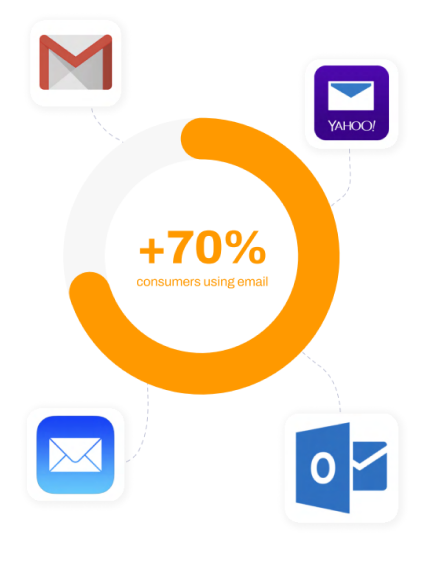

What is your preferred channel to receive marketing messages?
There you have it. Over two-thirds of Americans prefer email to any other channel. Also of note: newer channels such as SMS, push notifications, and social media have caught up to the preference for old-school direct mail.
What types of marketing emails do you most commonly receive?
Consumers don’t subscribe to emails just to hear marketing pitches. When prompted to pick their top three, the vast majority list a preference to receive cheaper offerings through promos (77%) and discounts (66%). Note that marketing pitches do generate interest, as roughly half of subscribers seek company updates (55%) and newsletters (50%).


How often do you check your email?
Checking emails has become second nature to many consumers, with the vast majority pulling up emails at least once a day. Nearly 40 percent, however, can classify themselves as super users, checking messages at least six times a day.
With constant communications from hundreds of entities, consumers want messages that stand out from the noise, and they’re willing to look however many times it takes.
What time of day do you most often check your email?
There’s a reason traditional email best practices prioritize early-morning send times. 60 percent of consumers check their personal email most often before they even eat lunch.


About how many unread emails are sitting in your inbox right now?
Despite checking their inbox multiple times a day, the average American has about 2600 unread emails. Those whose messaging does not stand out get lost in a sea of other companies with equally unengaging emails.
Even in a scenario that would get marked as a success, the average read time for a branded email amounts to a whopping ten seconds. Worse than an email being read and deleted, unopened emails signal subject lines cannot break through the noise and waste an opportunity to engage subscribers.
Marketers must overcome incredible odds just for subscribers to engage with emails.
Reaching the marketing fatigue tipping point
Email may have near-complete adoption among every demographic across the globe, but this does not equate to an infinite pool of revenue. Rather than operating under the myth that engagement correlates to output, campaigns must remain relevant and targeted to ensure consumers don’t experience marketing fatigue.
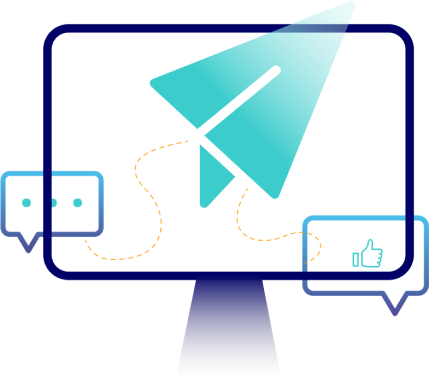
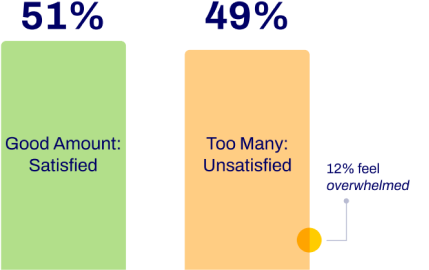
How many emails do you receive on a daily basis?
While roughly half of consumers are satisfied with the quantity of emails they receive each day, the other half feel marketing fatigue. Of special note, 12 percent of consumers feel they are saturated – totally overwhelmed by email and unlikely to want to engage with emails more than necessary.
For brands, marketing to these oversaturated consumers more often results in suboptimal conversions. It becomes nearly impossible to stand out and properly engage when consumers are marketing fatigued.
How often should companies email you with relevant content?
Ah, the duality of man. Despite leaving an explicit option for “multiple times per week,” over half (54 percent) of respondents prefer to receive relevant content at a minimal level. With data varying this dramatically, is it any wonder why marketers often have such a hard time engaging subscribers?
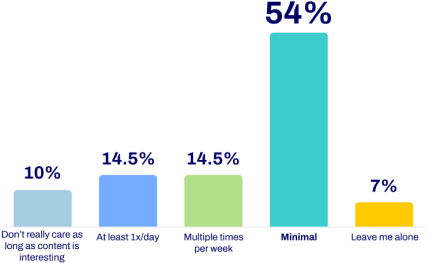
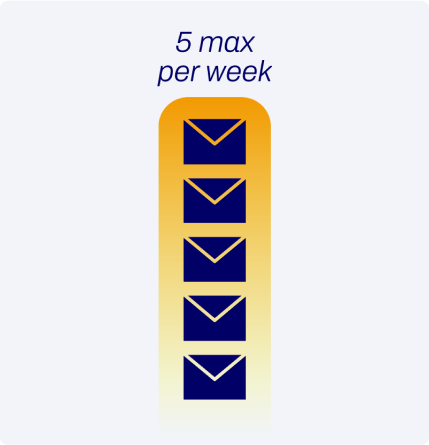
How many emails from a company within one week is too many?
To avoid marketing fatigue, brands must meet consumer expectations, here explicitly laid out at a maximum limit of exactly five emails per week. If current output across your teams’ campaigns currently exceeds this, look into prioritizing messages.
If, however, current output is currently below this threshold, there may be opportunities to optimally engage consumers who are undersaturated. As always, ensure any additional content provides value or else it might just contribute to a consumer’s overall sense of marketing fatigue.
Do you automatically allow app notifications on your phone?
Today’s omnichannel opportunities open the door to customer engagements no matter where they are. That doesn’t necessarily translate to success in practice.
When it comes to app notifications, for example, consumers typically don’t embrace automatic adoption, ranging from passive disapproval to outright hostility to the practice. Marketers need realistic expectations for how many communications they can send, depending on how audiences interact with the brand’s app.
For example, a highly engaged shopper is more likely to embrace promotional notifications than a shopper who downloaded the app six months ago for a promotion and hasn’t opened it since.

What contributes to marketing fatigue?
From the consumer’s point-of-view, there are two major pain points when dealing with marketing emails. First, oversaturation is a major problem that affects 41 percent of consumers, meaning there is a major gap between subscriber expectations and marketing output. Brands who oversaturate their audiences contribute greatly to marketing fatigue, so fixing this strengthens relationships and builds trust
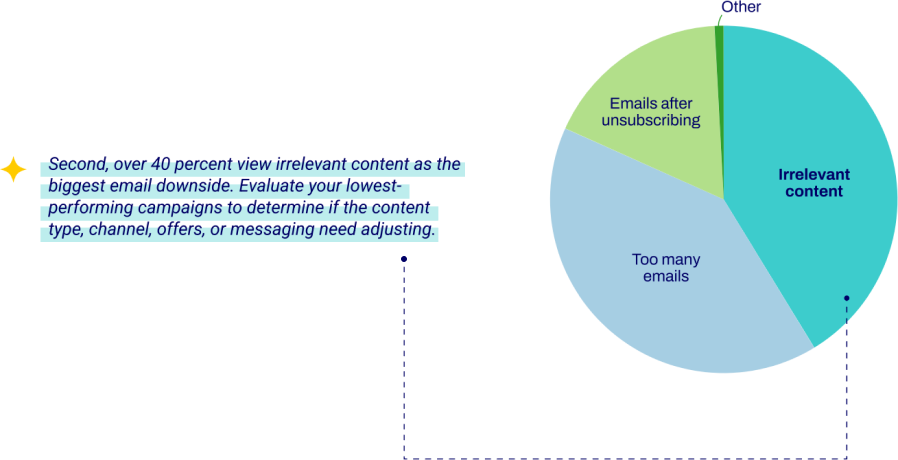

How do you react whenever a company you don't know well makes a clear mistake in an email?
(major typo, formatting issue, same email sent twice, wrong name used)
To follow up on that last point, we asked about what’s typically seen as a fatal mistake among marketers – quality assurance faux paus that distract from an email’s messaging.
The results are a mixed bag, but the good news for marketers – small mistakes don’t have major impacts on future engagement. Almost one-third will glance these over, and 31 percent will continue to engage, albeit with less credibility. In other words, these subscribers will continue to interact as long as the larger content offerings’ themes remain relevant, regardless if there is a typo or two.
The remaining 36 percent do see small mistakes as a fatal flaw, and there’s roughly an even split between those who will simply delete the email and those who will never want to interact ever again.
Data Compliance Is Also a PR Issue
No tech story dominates the headlines quite like data compliance. GDPR, CANSPAM Act, and even HIPAA set expectations for how marketers and organizations gather, distribute, and handle data. Organizations face legal liability for data breaches and poor procedures that violate these guidelines.
With even other tech companies such as Apple and Google going beyond governments to regulate how consumer data gets shared, data privacy has hit mainstream audiences. Turns out, the general populous also hates poor data handling and will view companies negatively if they operate unethically with their information.
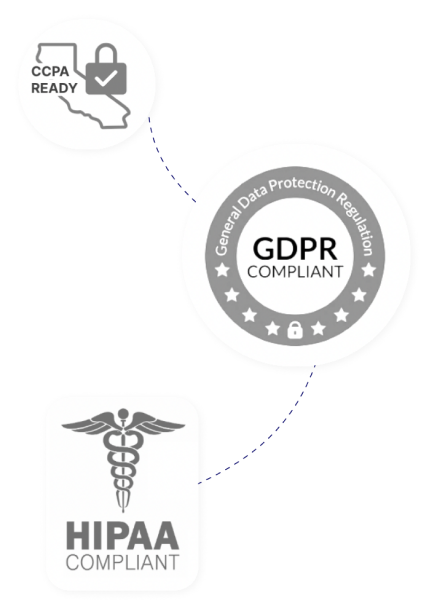
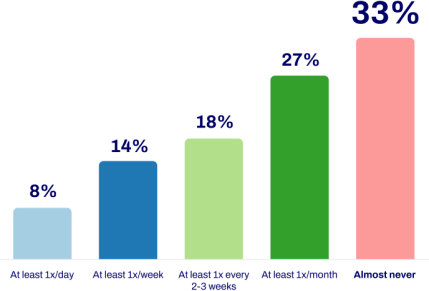
How often do you purposely sign up for emails?
(filling out newsletter forms, signing up for promos, creating an account)
In the post-third-party cookies era, first party data is crucial for marketers. Ensuring marketable contacts want to receive communications primes email databases for optimal engagement metrics.
As the survey shows, consumers are reluctant to share their personal data, opting to share information only with a select few brands that have earned their trust. A full one-third of these (try to) go out of their way to never sign up for any marketing emails.
Knowing this, how reliable is your database? If you don’t regularly clean out your contact database, here are some data management best practices to ensure you don’t risk actions that hurt your entire email domain’s deliverability.
Have you learned more about how companies use your personal data since companies like Apple started offering more control over how you can share it?
Apple’s efforts to increase user data privacy in recent years have put data acquisition practices in the spotlight. That news has shaped consumer attitudes, as 44 percent of consumers hadn’t heard of the campaign before. Another 27 percent independently supported data privacy measures before hearing about it in the news.
The implication for marketers – today’s consumers are privacy-conscious and have read up on how their data gets used. Learn more about data privacy compliance across multinational teams in Salesforce Marketing Cloud in this blog post.

Do you like when marketers use your shopping history to offer you relevant deals?
Thirty percent of consumers are a marketer’s dream, appreciative of abandoned cart campaigns they see as a reminder to follow up. Far more feel the opposite – in their eyes, these are invasive and violate a subscriber’s privacy.
Despite the major gap in attitudes, there are ways to balance the two. Having a reminder opt-in in the website’s settings, or a popup/option as someone adds their first product to the cart will capture both consent and contact information.
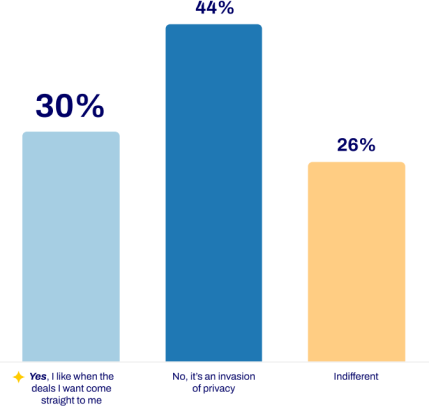

Do you wish there was more regulation and enforcement around email laws?
An overwhelming majority (85 percent) believe American data privacy laws need further regulation.
Organizations practicing poor data privacy go against these views, presenting a mismatch between company and consumer expectations that leads to disengagement.
Forward-looking marketers who prepare for future changes will be better off in the long run, with fully mature and compliant data collection methods their competitors do not have.
Overwhelmed Consumers Fight Back
Brands that oversaturate audiences don’t just run the risk of decreased engagement. When consumers reach the marketing fatigue tipping point, they will opt to cut off communications entirely through unsubscribing and/or marking as spam, preventing future engagement opportunities and leaving ROI on the table.
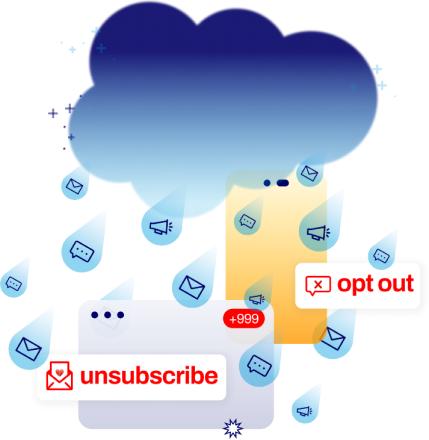

What do you do with emails you find irrelevant or overwhelming in quantity?
Not exactly a surprise, but consumers will ignore messages they do not want to receive. What should cause concern – almost half (45%) will unsubscribe if emails stay irrelevant and/or at an overwhelming quantity.
Ten percent represent the worst case scenario. Spam designations hurt email deliverability across the entire domain, limiting future campaigns and permanently severing ties with countless former subscribers.
In the last month, has a company emailed you after you unsubscribed?
Almost two-thirds of consumers (66%) report brands continue to reach out after unsubscribing, a surefire recipe for the aforementioned spam designations. Consumers who feel no way out of these messages will sever ties in the most effective way possible, so respecting these wishes is good for business in the long run.


How often do you find a useful email that accidentally went straight to spam?
Another consequence of high spam designations – missed connections. 84 percent of consumers say they find useful emails automatically filtered into the spam folder. The missed ROI off of these instances is entirely avoidable.
Would you ever shop again at a company (online or in person) that sent you so many emails you had to unsubscribe?
So how do brands avoid creating marketing fatigue and a spammy perception? Half (54 percent) of consumers say it comes down to two factors, the strength of the relationship and the content of the messages. For consumers with weak connections to your brand, the unsubscribe risk is especially high.
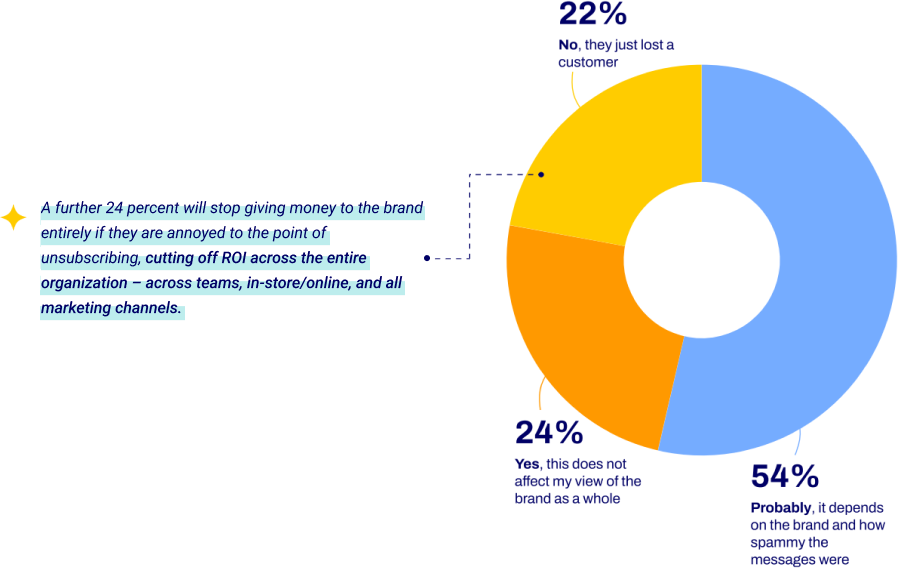
DESelect Engage: Build engagement, not marketing fatigue
The stakes are incredible. In a healthy relationship, subscribers feel value from marketing communications and feel comfortable engaging. On the opposite end, those who find little value or are overwhelmed will cut off all opportunities for future engagement.
To prevent these negative side effects of marketing fatigue, DESelect Engage gives marketers a single command center to fully control saturation. With real-time insights in how, when, and where customers receive communications, marketers understand what the right marketing mix looks like at a 1:1 level and where to make adjustments.

This comprehensive overview also ensures marketers know exactly which customers are undersaturated to prevent any missed opportunities and lost revenue. No matter how complex your omnichannel strategies or how siloed your teams, Engage gives marketers the data to create better customer experiences.
Engage prioritizes communications to each contact via the internal metrics and preferences each org sets, ensuring contacts receive the most important messages without oversaturating to the point of unsubscribing (or worse). Engage lets marketers get the right message to the right audience, at the right time…and the right amount of times.
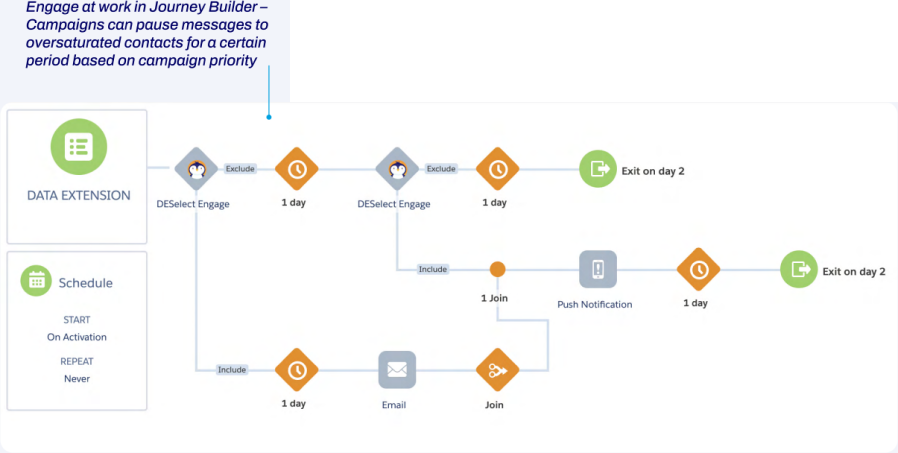
Key Takeaways
Evaluating how consumers view email sheds light on the evolving landscape of digital communication and provides valuable insights for organizations and their marketers. Moreover, the evaluation underscores the significance of trust and transparency in email communication.
- As consumers become increasingly selective in their email interactions, they are more inclined to engage with personalized and relevant content, while expressing a strong aversion to excessive promotional emails and spam.
- Understand your audiences’ messaging preferences to enhance engagement and foster positive brand-consumer relationships. If you get message frequency wrong, odds are you’ll forever damage the customer relationship.
- Consumers prioritize privacy and data security, and they overwhelmingly expect companies to handle their personal information responsibly. Build trust through clear and concise privacy policies, explicit opt-in procedures, and robust data protection measures.
- Develop a system to monitor audience saturation, ensuring contacts are primed for maximum long-term ROI. If you aren’t keen on having to manually keep tabs on every contact, let DESelect Engage be your 1:1 contact saturation guide.
* By aligning email practices with consumer attitudes, organizations cultivate lasting relationships with target audiences and cultivate maximum customer lifetime value.
Defend against unsubscribes, opt-outs, and marketing fatigue. But don’t just play defense. With DESelect Engage, create premium customer experiences that drive revenue, brand loyalty, and ROI.
Audience Data
Q1 Gender
Male: 62.50%
Female: 37.50%
Q2 Age
18-29: 22.41%
30-44: 21.55%
Male: 62.50%
> 60: 23.28%
< 18: 0
Q3 Device Type
Android Phone / Tablet: 34.48%
iOS Phone / Tablet: 58.62%
MacOS Desktop / Laptop: 2.59% Windows Desktop / Laptop: 3.88%
Other Phone / Tablet: 0.43%
Other: 0
Q4 Household Income
$0-$9,999: 4.31%
$10,000-$24,999: 13.79%
$25,000-$49,999: 19.83%
$50,000-$74,999: 18.97%
$75,000-$99,999: 12.93%
$100,000-$124,999: 6.03%
$125,000-$149,999: 5.17%
$150,000-$174,999: 2.59%
$175,000-$199,999: 2.16%
$200,000+: 6.90%
Prefer not to answer: 7.33%
Q5 Major US Region
East North Central: 12.61%
East South Central: 4.35%
Middle Atlantic: 14.35%
Mountain: 6.09%
New England: 4.78%
Pacific: 20.43%
South Atlantic: 19.57%
West North Central: 6.09%
West South Central: 11.74%


